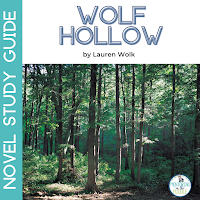Do you talk about death and dying in your classroom? It's a tricky topic, isn't it? I didn't bring it up unless it touched close to my students' lives. But I've found that books, especially ones I read aloud, could be a great way to get kids processing their thoughts about it.
A good number of my students had some experience with death - of a pet, a neighbor, someone from church, occasionally a relative. BUT, is it something you should introduce to your students?
I can see wanting to protect them, but I'd also make the case that classrooms are often some of the safest places for these kinds of conversations. One way to broach the topic is to read aloud to your students, and there are three books that come to mind:
- The Thing About Jellyfish
- Wolf Hollow
- The Bridge
Two of them are perfect for 5th and 6th graders, and one is probably best for slightly older students (although that's just my opinion.) These three books are very different from each other. In The Thing About Jellyfish, it's a former best friend. In Wolf Hollow, it's the neighborhood bully. And in The Bridge, it's a complete stranger.
The Thing About Jellyfish
Ali Benjamin wrote this book in 2015 and it was a National Book Award Finalist.
Imagine a book told from Suzy's point of view, that includes conversations she has with her deceased friend, Franny. Mix in some wisdom from Mrs. Turston, Suzy's 7th grade Science teacher, in the form of the stages of a science experiment. Which are metaphors for Suzy's life. Throw in a lot of scientific facts about jellyfish. And a kid - Suzy - who decides to stop talking. Add a divorced mom and dad, a brother with his boyfriend, and you have the makings of something that sounds unusual.
You can read more about the book here. I also created a novel study guide if this is a book you want to explore with your students.
Wolf Hollow
Annabelle is growing up in a rural Pennsylvania community in 1943 where things are mostly peaceful. Until Betty moves in with her grandparents. Betty is cruel and seems to thrive on threatening people. At first, Annabelle tries to stay away, despite her mother's encouragement to befriend Betty.
Toby, an older World War I veteran who is strange but kind (suffering from PTSD) wanders through the woods nearby and is tolerated by most of the townspeople. Although Annabelle doesn't understand him, she is comforted by his presence in the woods where Betty seems to inflict the most harm, away from the presence of adults.
Then one day, Betty goes missing and Toby immediately becomes the prime suspect. Annabelle is convinced of Toby's innocence. When Annabelle is discovered dead in the woods, the stakes grow higher still.
This haunting story, powerfully told by Lauren Wolk, will spark important conversations about bullying, judging, gossip, and reasons for injustice.
The Bridge
I was introduced to this book in a more round-about way but I'm so glad I did! Bill Konigsberg wrote an open letter to parents who were trying to ban his book from their school district in Texas. His thoughtful response prompted me to read the book. You can read his letter here.
Aaron has just walked to the middle of the George Washington Bridge that spans the Hudson River and separates New Jersey from New York. He is depressed and lonely and is planning to jump off the bridge. As he thinks over his plan, he becomes aware of someone nearby. Annoyed, he looks up.
And watches Tillie jump to her death.
That's one possibility. Another is that Tillie goes to the bridge, planning to die, and instead sees Aaron jump.
Or maybe they both jump.
Or perhaps neither of them does.
And that's the power of the book. In what I view as a life-encouraging approach, Konigsberg looks at the impact that each of these decisions makes on Aaron's and Tillie's friends and family. The sadness and hurt, the bewilderment about what could have been done are realistically told. The book also explores how difficult it is to be depressed or anxious and have others understand how to navigate that and provide help.
Despite the subject, I found Konigsberg's writing to be a positive approach to depression and suicide. In my classroom, this would have been a book that required parent permission (I had a small collection of books in that category because of language or content; about half of my parents gave permission.)
I hope you'll give all of these books some consideration!





No comments
Post a Comment